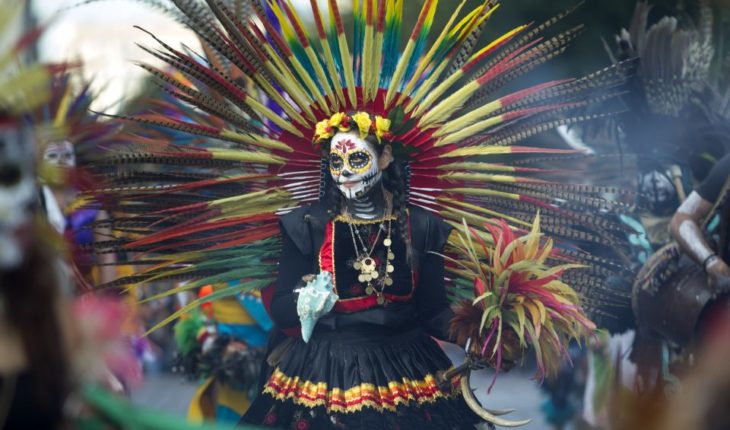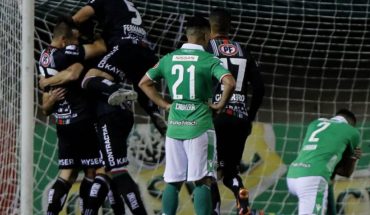Monumental skulls, allegorical chariots, catrinas, giant puppets, the characteristic color and smell of cempasúchil flowers, and the aroma of incense will guide this Saturday, November 2, the Mega Day of the Dead Parade.
The tour will start at 13: 00 hours in the Estela de Luz, very close to the Chapultepec Metro, and advance on Paseo de la Reforma, continue along Avenida Juárez until it takes May 5 and reach the Zocalo, where the Monumental Offering will be installed.
The parade will feature 30 artistic projects and various choreographic groups that will fill the streets of Mexico City with color, to evoke funeral rituals around the world, and especially typical Mexican rituals, with traditional dresses and More.
Read: 7 offerings and altars in CDMX to visit this Day of the Dead
More than three thousand artists will participate in this parade and you will be able to see 12 allegorical chariots, 50 comparsas, monumental puppets, chinelos, tecuanes, stridens, jugglers, acrobats and other stage contingents with eye-catching costumes and themed masks.
“The cultural procession will bridge the pre-Hispanic past and the Catholic rituals of the Colony,” according to the Ministry of Culture, so you can enjoy monumental constructions, some pre-Hispanic and others of the twentieth century.
In addition, the parade will be attended by a delegation from China, who will show attendees the ritual that is performed in that country to remember and venerate their dead.
The Ministry of Citizen Security (SSC) of Mexico City reported that 1,890 police officers will participate in the operation to ensure the safety of visitors.
The parade will last approximately four hours. It is recommended to arrive early to have the best view, wear comfortable clothes and shoes, hat or hat and water.
On this occasion, the Monumental Day of the Dead Offering “Altar of altars” in the capital Zocalo represents the festivities and offerings of northern, south, east and west of Mexico.
The Altar of the North symbolizes the Yaqui people of Sonora, in that region the offerings with water and food are placed on four mesquite trunks that form pallets.
In #AltarDeAltares you can get to know Sonora through a Yaqui tapanco, like the one these northern inhabitants put in to receive the buds in #DíaDeMuertos2019. #CapitalCultural pic.twitter.com/CXSlBiixh3
— Culture Mexico City (@CulturaCiudadMx) November 1, 2019
For its part, the Altar of the West is a sample of the culture of Cuanajo, Michoacán, where flowers and fruits are on pink wooden horses, which carries people through the streets to the house of the deceased, to recognize the abode.
The tradition of #DíaDeMuertos2019 of the village of Cuanajo, Michoacán, is reflected in #AltarDeAltares with an offering of flowers, fruits and corn that the inhabitants usually place on wooden horses. #CapitalCultural pic.twitter.com/owLg8rW3cP
— Culture Mexico City (@CulturaCiudadMx) November 1, 2019
The Altar of the South represents Yucatan with “the food of the animas”. In this area the tamales are cooked underground and are accompanied by atole, brandy and wild flowers.
A traditional altar of Yucatan is erected in #AltarDeAltares in honor of the celebration known in that territory as Hanal Pixán, “food of the animas” in Maya, in which tends to place seasonal fruit and prepare typical dishes. #DíaDeMuertos2019 pic.twitter.com/ZQc8FZGT7j
— Culture Mexico City (@CulturaCiudadMx) November 1, 2019
The Huasteca is represented by an arch of Xantolo (celebration of the dead in the region), which symbolizes the portal between the earthly world and that of death.
The Altar of Altars was assigned to Vladimir Maisilin, who won the popular consultation to choose this year’s offering. He explained that each element of the offerings was made by Mexican hands, and that this year the goal was to show the diversity of the holiday throughout the country.
In #AltarDeAltares also narrate the four worlds where the dead are directed in the Mexican worldview: the Mictlán, the Tonatiuhichan, the Tlalocan and the
Chichihuacuauhco. #DíaDeMuertos2019 #CapitalCultural pic.twitter.com/ed8zZeYzzz
— Culture Mexico City (@CulturaCiudadMx) November 1, 2019
Metrobus to close stations
The Metrobus reported that on November 2 there will be closures at some stations on the lines from 12:00 to 18:00 hours due to the Mega Day of the Dead 2019 Parade.
Line 1: Suspend your service from 12:00 to 15:00 hours at the Hamburg and Reform stations, so only the Green-Place of the Republic Indian and Glorieta de los Insurgents-El Caminero circuits will be open.
Line 3: From 12:00 to 16:00 hours the Mina and Hidalgo stations will remain closed, and the Tenayuca-Buenavista and Juarez-Ethiopia circuits will operate.
Line 4: It will have no service from 12:00 to 19:00 in the Stations Buenavista, Delegation Cuauhtémoc, Puente de Alvarado, Bellas Artes, Glorieta de Colón, Plaza de la República and Museo de San Carlos, and in its normal hours the Expo Reforma-San circuits will operate Lazarus on Ruta Sur, as well as Teatro Blanquita-San Lázaro in Ruta Norte.
Line 7: From 10:00 to 15:00 hours will be closed the stations that go from Campo Marte to Caballito, schedule in which there will only be service in the Indios Verdes-Hidalgo circuits and Hospital Infantil La Villa-Hidalgo.
The festivities held over the weekend, which included the Procession of the Catrinas, the Formula 1 sporting event and the tribute to José José brought together more than two million inhabitants and visitors, who left an economic spill of more than 4 billion in hotels and restaurants in the capital, reported the capital government.
#MovilidadCDMX
By mega Day of the Dead parade, we share the following information from our service. Take forecasts. pic.twitter.com/3yvwSN3jAU
— CDMX Metrobus (@MetrobusCDMX) November 1, 2019
If you plan to be close to the place we recommend using alternative routes.
To avoid the area, the Road Information Center of the Ministry of Citizen Security of Mexico City recommended using:
– Indoor Circuit to the north and south
– Ring of Circumvalation
– Axis 1 North
– Chapultepec, Doctor Río de la Loza and Fray Servando Teresa de Mier avenues.
-Avenidas José María Izazaga, Arcos de Belén and its continuation along Chapultepec Avenue.
What we do in Animal Político requires professional journalists, teamwork, dialogue with readers and something very important: independence. You can help us keep going. Be part of the team.
Subscribe to Animal Politician, receive benefits and support free journalism.#YoSoyAnimal





